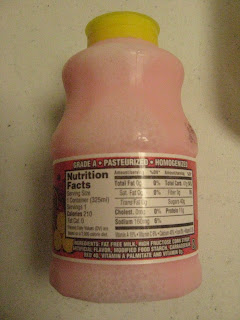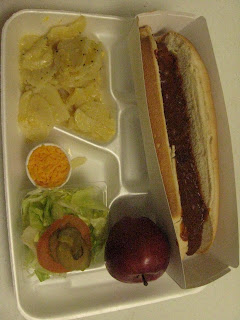Robert Courtemanche blogs as Teach_J at his site http://www.teachj.wordpress.com/. His blog focuses on teaching resources for journalism and media tech. teachers in secondary schools. He has been teaching for 15 years and blogging for three.
I’ve been enjoying Fed Up With Lunch for more than a month now and answered the call to guest blog. I am really interested in the way that we decide what to feed our students and how often they eat the same meals. And I also wonder about the healthiness of the meals we serve.
I chose to eat one day in the cafeteria. I don’t usually do it, and when I do I take the option, like the Coach in Mr. Holland’s Opus, to cut the line. At my school (a large urban public school in a metro area in Texas) we have exactly 26 minutes to eat lunch. Coming from the world of television 15 years ago, I was appalled that I didn’t get an hour for lunch.
Unlike Mrs. Q, I got to choose my day and pick a day I might enjoy the food. So, here was my lunch: Potatoes Au Gratin, Foot-long Chilli Dog, Crispy Vegetables, a Red Apple and Strawberry Milk. I could have had a Green Apple and Plain or Chocolate Milk as choices.
I found the lunch of fairly good quality. The potatoes were tasty, but a little watery. I’m sure it is hard to make this for nearly 2,000 kids. I’ve made this dish myself at home and had worse results. The footlong was filling and not bland. I’ve had just as good hot dogs at many high school sporting events. The veggies were cold and crisp and the apple still crunchy. My milk was cold, but came in at 210 calories, which does seem a little high. I think it is great that the label says fat-free (skim) milk, but also that corn syrup is the second ingredient. Not so good.
I was able to chat via email with both the director of student nutrition and the secondary cafeteria manager. They both mentioned the fact that our school no longer fries any foods, we use whole grains in many products and many items are made from scratch. One of the healthiest options that are available are the pizzas made with whole grains, low-fat cheese and turkey pepperoni. Sodas are no longer sold on campus and nearly all snacks are low-fat and reduced calorie varieties, such as baked lays chips.
The quick three-week food rotation of the meals helps them with food costs and meal preparation training. I know from when one of my newspaper students did a story on the cafeteria several years ago, the cafeteria is run on a not-for profit, not-for loss basis, by a contracted company. Between the demands of federal and state mandates and the costs associated with running such a massive kitchen, the margins for error are small when it comes to cost overruns.
After reading this blog and watching the ABC show Food Revolution – and now reading the emails from my district nutrition specialists – I’m more convinced than ever that the USDA guidelines are still messed up. I think our cafeteria staff have nearly as many demands and mandates as we teachers do. And they are under nearly the same kind of fire as we are. Many of these directives seem to make it harder to cook healthy. And if the government wants to get serious about healthier lunches, then the funding must come too.


The last paragraph sums it up best! I am a dietitian in a pediatric day clinic and am responsible for making out the menus. It is almost impossible to serve healthy food even some of the time due to USDA, cost restraints, and food warehouse availability.
"Low-fat" equals "high sugar"! Don't believe the hype:
http://nutrition-and-physical-regeneration.com/blog/3150/cholesterol/lessons-neighbors-refrigerator/
"If your heart, bones, liver, brain, lungs, nervous system, and immune system are important to you, then ditching saturated fat puts those organs and systems at risk. It does not provide a nutritional enhancement."
Information on healthy foods has been ignored and suppressed because it conflicts with govenrment recommendations, which are based on bad science and agricultural lobbying. Ask yourself why the "food pyramid" doesn't come from the Food and Drug Administration, or the Department of Health, but the Department of AGRICULTURE?
(The five most heavily subsidized crops in the country are wheat, corn, soy, rice, and cotton. And by an unsurprising coincidence, all of those are bad for humans when eaten, although white rice appears the least harmful.)
School lunches are a classic example of #4 in this Milton Friedman explanation:
http://37signals.com/svn/posts/2190-milton-friedman-on-the-four-ways-you-can-spend-money
Great guest post! I like that your district is trying by implementing changes, though there's always more that can be done (that strawberry milk has a ton of sugar and calories!).
While the current USDA regulations seem messed up and cumbersome, watch out for the new legislation (Healthy, Hunger-Free Kids Act) which may make everything worse. It sounds great, but there will be more control by the federal government in the form of dictating what schools are allowed to serve, in exchange for an additional 6 cents per meal. A one-size fits all approach may be disastrous, certainly erodes local control, and could dismantle a lot of good things school districts are already doing. Keep in mind that the government currently considers ketchup and fries to be two acceptable servings of vegetables. Who knows what the USDA will mandate? The USDA is supposed to base the standards on the Institute of Medicine's recommendations, but who knows what the end result will be? The IOM may be fairly independent, but the USDA is likely heavily lobbied by the corn (i.e., corn syrup) and other food industries that don't want to see their products restricted. What if calorie restrictions are put in place in the form of a nationwide standard? Would the same standard be appropriate in an average community vs. a community where most of the kids do a lot of farm and ranch work (and therefore need more calories)?
One of my readers sent me this link today.
I'm glad to see someone else posting that their school lunches aren't all pre-packaged and unappealing. Reading this blog makes me feel very grateful for our GOOD school lunches!
I have to say that I love reading this blog. It really makes me stop, think and wonder about what school lunch was and what it has become. The next time that I'm subbing at the school I may have to take a peak in the cafeteria.
I grew up in the Birdville school district in Ft. Worth so I just wanted to say hi neighbor. I don't remember much about the food, but I do remember a few meals I really liked as a child. I also remember in high school when they started bringing in Chick-Fil-A sandwiches two days a week, really healthy, no?? (kidding)
Ketchup is not considered a vegetable. Never has been. Potatoes of any kind (yes, that could include french fries) ARE currently counted as a vegetable.
Coming up with regulations that are suitable for all schools is a challenge indeed.
Interesting to compare what the food department deals with and what the teachers deal with. They both face stress in the workplace b/c of antiquated and ridiculous guidelines that are barely achievable without cutting corners. The government needs to wake up…